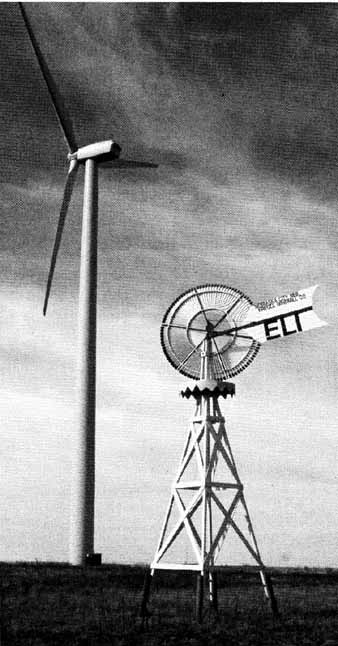Unbeknownst to many, winds are generated by solar energy. For example, in
coastal areas offshore winds are created by sunlight warming nearby land masses,
Hot air, created when sunlight strikes the land, rises.
Cool air from nearby
water bodies — large lakes or the oceans — rushes in to fill the gap, creating
winds.
Even large air movements across entire continents are driven by the differential
heating of the Earth’s surface. During the winter, for instance, the poles
are cooler than the equator. Hot air rises in the equator and cooler air
from the poles moves down to replace it.
The result is that huge Arctic air
masses (storms) sweep across the continent, bringing cold air as far south
as southern Florida,
Humans have tapped the power of wind energy for centuries, first to power sailing vessels and later to grind grain and pump water, The very first wind generators were believed to be used in Persia in the 5 century AD. Wind machines spread from the Middle East to Europe in the 12 century AD. From Europe wind technology spread to North America; by the late 1800s, there were thou sands of wind machines in Europe and North America in rural settings. From the late 1880s to the early l900s, more than eight million windmills, most of which were used to pump water for livestock, were installed in the United States, according to the National Renewable Energy Laboratory (___ 8-2).

This old wind machine, which is still functional today,
was once a common sight on the plains of North America, where it was used
to pump water for livestock. Its larger cousin, which produces electricity
in the background, is now becoming a much more common sight.
In the l920s, however, American cities began to electrify thanks to the pioneering work of Nikola Tesla, the brilliant scientist who invented equipment that made AC electricity possible. At first, the electricity that powered cities came from centralized power plants that burned coal. Electric lines strung here and there like spider webs throughout cities delivered electricity to homes, offices, and factories, By the end of the 1920s, North American cities were completely electrified. Oil lamps were a thing of the past. But things were quite different in rural areas. There were no central power plants to deliver electricity. Small wind turbines were the sole source of electricity on farms.
The US government then set its sights on rural areas, launching the Rural Electrification Program. With this ambitious program, wind power entered into a period of steady decline. It did not die out completely, though. Many small windmills continued to pump water to fill stock tanks on the Great Plains, and some are even working today. (Some areas of the Midwest weren’t electrified until the 1970s.)
Then came the 1970s and oil shortages. Although the crises were artificial, they fueled tremendous interest in energy self-sufficiency, conservation, and renewable energy. Wind benefited greatly, even though it was largely liquid fuel supplies that were threatened by the oil embargoes of the 1970s, By the early 1980s, there were 80 companies manufacturing wind machines in the United States, including large commercial generators and smaller household-sized units, During this exciting period, several utility companies in California built large wind farms to provide electricity to residents in San Francisco.
FYI: From the late 1880s to the early 1900s, more than eight million wind turbines were installed in the United States, most of which were used to pump water for livestock.
Unfortunately, early wind machines were plagued with mechanical problems and frequent breakdowns, Large commercial wind machines, for example, could only be counted on 60 percent of the time. They were broken down and out of service the rest of the time.
The early models were also fairly inefficient, These technological problems, combined with a growing lack of concern over achieving energy independence, caused wind power to decline. Because of wind energy’s bad reputation, many people lost interest in this important technology, and many people today continue to view wind power with undeserved skepticism.
Convinced of wind’s importance, several manufacturers began to tackle the technological problems that arose in the 1970s and early 1980s and greatly improved their products. Thanks to their efforts, and the work of the National Renewable Energy Lab in Golden, Colorado , the efficiency of large commercial wind machines increased, climbing two or three times above efficiencies achieved in the 1970s and early 1980s. Reliability increased as well, climbing from 60 percent to an astounding 97 to 99 percent. Small wind generator manufacturers also improved the design of their machines, simplifying them and getting rid of parts, like the brushes, that required frequent replacement. These improvements have created resurgence in wind power production. Today, wind power is the fastest growing source of energy in the world!
Next: Fundamentals of Wind Generators